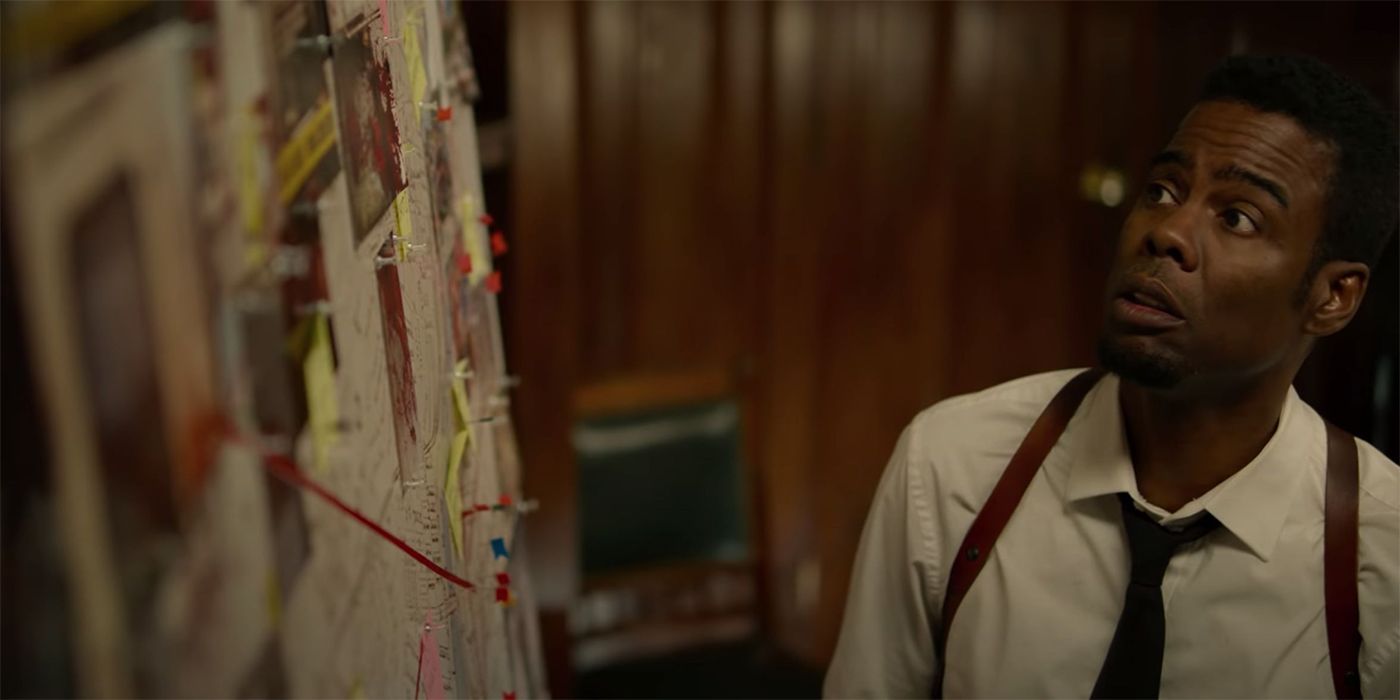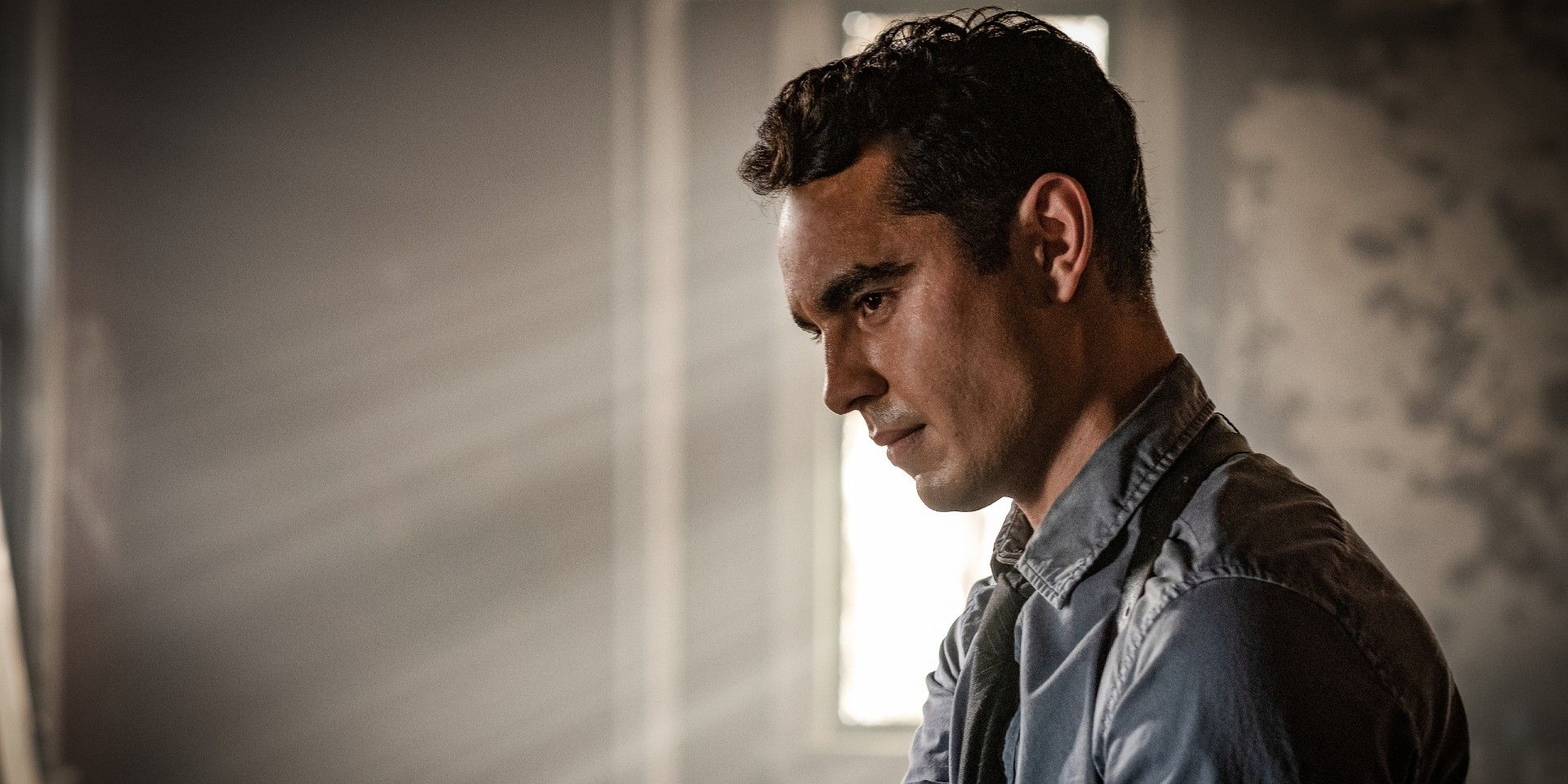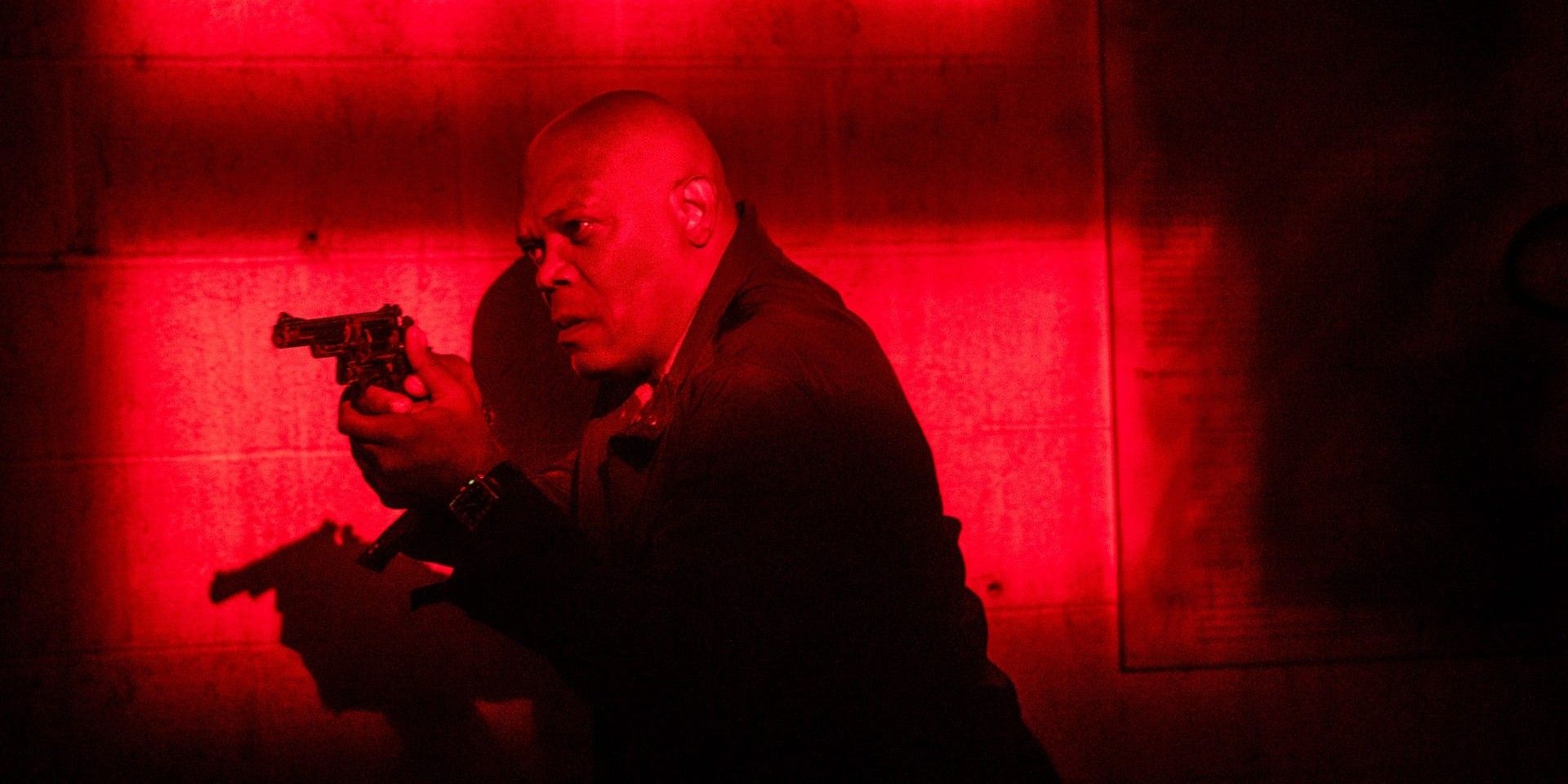Spiral: From the Book of Saw brought back plenty of brilliant minds from the Saw franchise, including director Darren Lynn Bousman. But it also turned a new leaf in the story, which meant recruiting new blood, including cinematographer Jordan Oram. Previously best known for Drake's Grammy-winning music video, "God's Plan," Oram brightened the shadows of the screen and turned the heat up to create tension.
After all, Spiral focuses on the cops following the trail of the latest trap-laying serial killer. Using one of Jigsaw's quirky calling card symbols, William Schenk (Max Minghella, The Handmaid's Tale), has made it his mission to enact vengeance on the police officers who have overseen gross miscarriages of justice - Samuel L. Jackson's ex-police captain Banks and new captain Angie Garza (Marisol Nichols, Riverdale) among them. The only cop he hopes to bring over to his side is Zeke (Chris Rock), leaving the door open for future Spiral stories.
Spiral: From the Book of Saw arrives on Digital July 13 and on 4K Ultra HD, Blu-ray, DVD, and On Demand July 20 from Lionsgate. Oram spoke to Screen Rant about his surprising journey to film, the collaborative environment on set, and whether he'd return for more Saw.
Screen Rant: I love the story of how Darren approached based on your music video for Drake's "God's Plan." But what was it that spoke to you about the script and got you excited to take on your first major feature film?
Jordan Oram: It was my first studio film, I would say. It was the first one that really had merit to it. The fact that it was a franchise that was recognizable internationally was a major thought. The cast and the conditions of the script were also fascinating, because the Saw franchise having someone like Chris Rock at front of it is unique in itself. And having Samuel Jackson and Chris Rock in their first movie together ever just made it a little bit more enjoyable.
There is a distinctly different visual approach to Spiral as opposed to previous Saw films. Did you specifically comb through the franchise to decide the next step? Or did you approach it directly with a new vision in mind?
Jordan Oram: It was a little bit of both. When Darren and I had our first conversations about the universe that we were looking to create with this movie, I referenced the other eight films.
This being the first one out of the studio, I was very adamant about creating a film that had a distinguishable look to it across the board. It was monochromatic palette, but it was peaceful. One really cool reference was the hottest day of summer, like in Spike Lee's Do The Right Thing. We just knew that we wanted to make something that had the same style consistently across the viewing of the movie, so I did my best to enable what that looked like across our interiors and exteriors.
What was your collaboration process with Darren like? What perspective would you say your music video experience brought?
Jordan Oram: Yeah, I think working with Darren was definitely a dream come true. His brain is constantly moving, and he's always challenging me to think outside of the box.
What I definitely learned is that the time that you have is the most important in any form of filmmaking. What I brought with me from my music video experience was just how much time we really need to develop a look, in terms of color palettes or consistent themes across the space. To create multiple universes, even in the same space, you have to create a different feeling. It was actually very challenging.
Do you have a favorite trap that you filmed, or one that was most challenging and memorable for you?
Jordan Oram: I think one that I was looking forward to was the first train track, at the beginning of the movie. We had built a really unique set for that; it was forced perspective, so most of what you see is not actually there.
But I also think that successfully dictating how someone hanging from their tongue is very difficult. The timing of the train and the things that we needed to do to approach that were all interesting.
I'm fascinated by how you came up the ranks to become a cinematographer specifically. How has working in various other aspects, like key grip, helped shape your abilities as a DP?
Jordan Oram: For me, it really comes down to the respect that I carry for the crew that I work with. It starts from the top to the bottom, so how can I place myself where the bottom of the food chain exists and just allow myself to see from another perspective? It's how to ask them for what I'm looking to accomplish.
It's important to know that I was also someone looking for mentorship and now I am a role model for those that are coming up. Because I came from Vimeo film school and YouTube and Google - I never went to film school - it's very important to be that example.
You had a large crew work with you. Were those people that you brought with you or that you began collaborating with on the set?
Jordan Oram: When I worked on Spiral, I worked with a whole new crew that I'd never worked with before. It was my first union job and it was all a learning experience. I had to learn the ropes of what the union was all about and I also had to understand how the producers and directors communicated and executed their vision.
Are you excited to or are you already in the process of working on new films after your experience with Spiral?
Jordan Oram: Absolutely, the door has been completely spread wide open because of the experiences that I had on Spiral. I'm definitely opening up the opportunity to do more international films, studio or independent. And I've been working on some really cool projects now since the release.
The spiral being the link between John Kramer and Schenk was very interesting. Were there any visual cues you focused on to showcase how different and yet similar this new iteration of Jigsaw-like killing is?
Jordan Oram: That's a good question, actually. There wasn't anything that I used to help Detective Schenk have a determined visual language because his character does so much of the storytelling. For us, I think the duality between Detective Schenk and Zeke was so strong that if I had done anything to give it away, it would have spoiled the texture of it.
I think I'm working in authenticity, and the subtlety allowed it to be real. It didn't feel like previous movies had done with John Kramer; this felt like a whole new twist. It needed to be captured in the most the authentic way for it to feel the way it does feel now.
There is a great amount of diversity and representation onscreen, and I love how you lit different skin tones without dulling, obscuring or washing them out. What advice could you impart to those who struggle with it?
Jordan Oram: Yeah, I think it really just comes down to the psychology of lighting itself. One of the biggest things that I experienced prior to this was understanding why it was so difficult to light darker skin tones.
People don't realize that darker skin tones reflect light, so you don't actually have to light the person; you have to light the surfaces they come close to. Often, if you light a big wall beside your character, that light naturally reacts to the skin tone because the skin color's refracting the light around it. For me, it's a lot easier to light darker skin tones because they naturally want to play in a silhouette space. It's easier to backlight skin tones easier because you're capturing the depth and tonality of it, and then you can reflect that light to really light the subject.
I really tested what it was like to focus warmer skin tones using tungsten light sources, because it naturally wants to be enriched and moisturizing the skin. So, it was finding a unique space and not overexposing characters in dual frames. With Max and Chris in multiple frames, you naturally are going to get some type of visual cue.
I was also working with Wardrobe to ensure that the characters with darker skin tones aren't placed in darker wardrobe. Instead, putting them in white shirts creates a natural bounce for their skin tones.
I would hope we get more adventures with Zeke and William, or even a prequel with Angie and Marcus. Have you spoken with anyone about there being more Spiral, or would you want to return for more?
Jordan Oram: Yeah. I spoke to Mark Berg, the executive producer, about another Spiral episodic piece or another version that I think they're working on now. If the opportunity and time presented itself, absolutely.
The reality of working in this genre is something very new to me. It's not my genre of choice, but I spent my time in it and did it justice. I'm happy that viewers are able to take something that I created away from it, and that it added to the story. So, I'm just happy to be part of that.
What would be your genre of choice? What do you gravitate more towards, in terms of material?
Jordan Oram: I like thrillers, and I like things that have anything to do with human behavior. It's just a way of realizing and remembering that things are real in this universe. When things are made up, it's hard to try and picture it. But I like to recreate what is real, ultimately.
Right now, I'm not terribly picky. I just want to do the collaborations that I have justice, both on and offscreen.
With this being your first large-scale feature film, what was some of the most important or surprising lessons you learned?
Jordan Oram: The most important lesson I took away was prep. Confidence and courage was most mostly what got me through this entire process.
There were so many first-time experiences for me on the set. Working with Chris and Max and Sam and Marisol [Nichols], these are high-profile celebrities that are bringing with them so much experience. It being my first union job and my first studio experience, all of these things compiled and stacked onto themselves. It almost puts the odds against me.
But I think the odds were actually in my favor on this project because I just approached it with sincerity. I was willing to adapt to what was going on, which I think was probably the biggest takeaway from this project.
Spiral will be available July 20 via 4K UHD Blu-Ray, Blu-Ray, DVD and On Demand.



